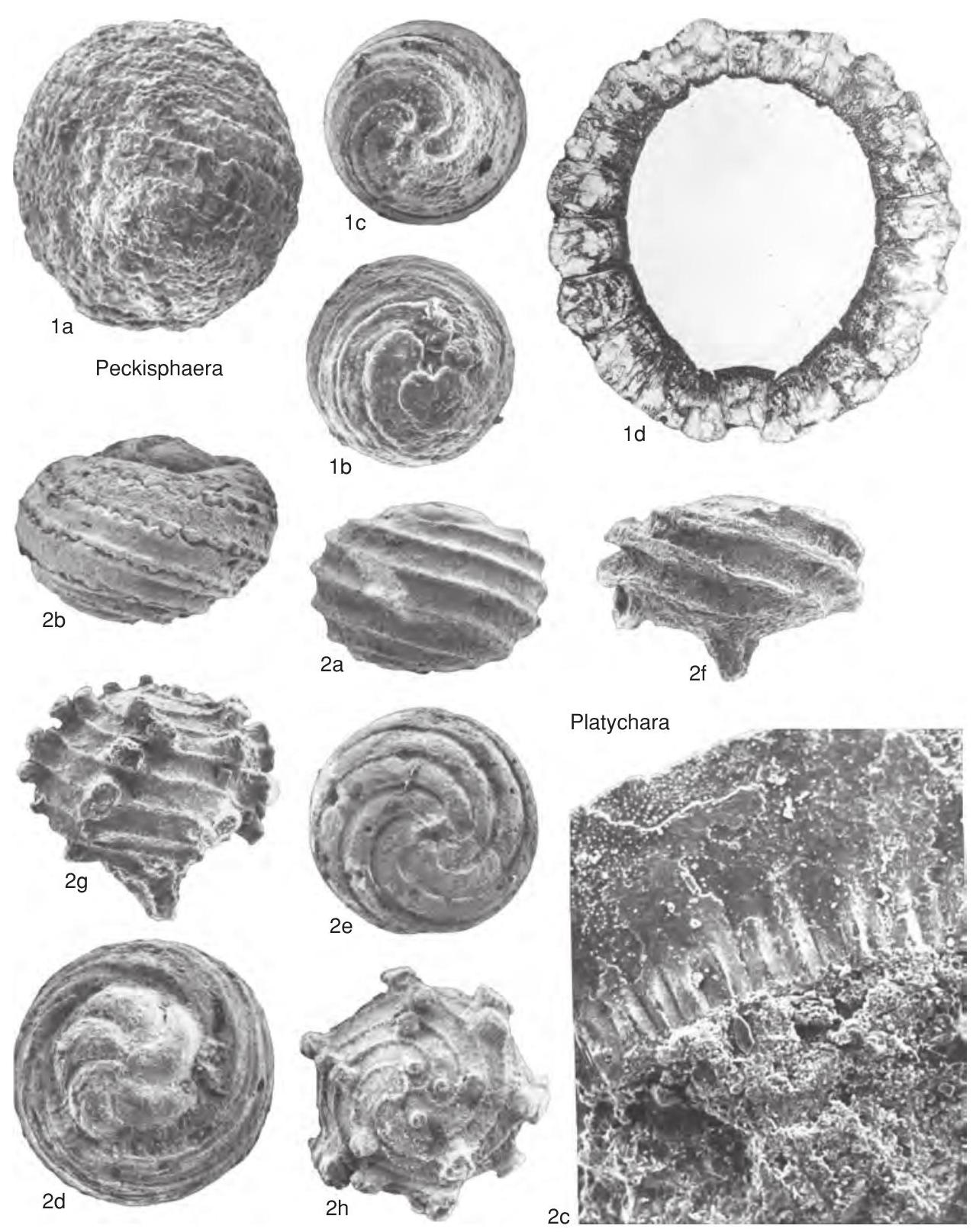Welcome to the Treatise on Invertebrate Paleontology!
Please enter a genera name to retrieve more information.

Platychara
Classification
Phylum:
Class:
Order:
Charales
Superfamily:
Unknown
Family:
Characeae
Formal Genus Name and Reference:
Platychara GRAMBAST, 1962b, p. 76
Type Species:
Chara compressa Knowlton, 1888, p. 156, fig. 1-2, OD, non KUNTH, 1815
Images
(Click to enlarge in a new window)
Fig. 74,2a-e. * P. compressa (Knowlton) Grambast, Upper Cretaceous, USA, topotypes, a, lateral view, C.1229-1, x40, b, lateral view, C.1229-2, x40, c, wall structure of spiral cells, C.1229-5, x300, d, apical view, C.1229-3, x40, e, basal view, C.1229-4, x40 (new).——Fig. 74,2f. P. complanata Grambast & Gutiérrez, Upper Cretaceous, Spain, holotype, lateral view, x78 (Grambast & Gutiérrez, 1977, pl. VI, 1).——Fig. 74,2g-h. P. stipitata Grambast & Gutiérrez, Upper Cretaceous, Spain, g, lateral view, paratype, h, apical view, x100 (Grambast & Gutiérrez, 1977, pl. VII,5a-b).
Synonyms
Geographic Distribution
Canada, Mexico, USA, Argentina, Bolivia, Jamaica, Peru, Belgium, France, Spain, China, India
Age Range
Beginning Stage in Treatise Usage:
Upper Cretaceous-Paleogene (Paleocene)
Beginning International Stage:
Danian
Fraction Up In Beginning Stage:
0
Beginning Date:
66.04
Ending Stage in Treatise Usage:
Paleogene (Paleocene)
Ending International Stage:
Thanetian
Fraction Up In Ending Stage:
0
Ending Date:
56
Description
Apex nitellopsidoid, periapical zone variably thinned and slightly or not narrowed, apical nodes convex and elongated, general shape oblate, suboblate to oblate-spheroidal, base similar or spirals turned downward around basal pore to form small cone or distinct column, spirals smooth or with tubercles or crests, basal plate slightly calcified, not visible from exterior, size small to large. [differs from Gyrogona in being distinctly wider than high, in having wide spirals, continuous periapical furrow, and frequently a basal extension, in species with a protruding base, gyrogonite height may equal width or slightly exceed width.]
References
Museum or Author Information
Classification
Phylum:
Class:
Order:
Charales
Superfamily:
Unknown
Family:
Characeae
Formal Genus Name and Reference:
Platychara GRAMBAST, 1962b, p. 76
Type Species:
Chara compressa Knowlton, 1888, p. 156, fig. 1-2, OD, non KUNTH, 1815
Images
(Click to enlarge in a new window)
Fig. 74,2a-e. * P. compressa (Knowlton) Grambast, Upper Cretaceous, USA, topotypes, a, lateral view, C.1229-1, x40, b, lateral view, C.1229-2, x40, c, wall structure of spiral cells, C.1229-5, x300, d, apical view, C.1229-3, x40, e, basal view, C.1229-4, x40 (new).——Fig. 74,2f. P. complanata Grambast & Gutiérrez, Upper Cretaceous, Spain, holotype, lateral view, x78 (Grambast & Gutiérrez, 1977, pl. VI, 1).——Fig. 74,2g-h. P. stipitata Grambast & Gutiérrez, Upper Cretaceous, Spain, g, lateral view, paratype, h, apical view, x100 (Grambast & Gutiérrez, 1977, pl. VII,5a-b).
Synonyms
Geographic Distribution
Canada, Mexico, USA, Argentina, Bolivia, Jamaica, Peru, Belgium, France, Spain, China, India
Age Range
Beginning Stage in Treatise Usage:
Upper Cretaceous-Paleogene (Paleocene)
Beginning International Stage:
Danian
Fraction Up In Beginning Stage:
0
Beginning Date:
66.04
Ending Stage in Treatise Usage:
Paleogene (Paleocene)
Ending International Stage:
Thanetian
Fraction Up In Ending Stage:
0
Ending Date:
56
Description
Apex nitellopsidoid, periapical zone variably thinned and slightly or not narrowed, apical nodes convex and elongated, general shape oblate, suboblate to oblate-spheroidal, base similar or spirals turned downward around basal pore to form small cone or distinct column, spirals smooth or with tubercles or crests, basal plate slightly calcified, not visible from exterior, size small to large. [differs from Gyrogona in being distinctly wider than high, in having wide spirals, continuous periapical furrow, and frequently a basal extension, in species with a protruding base, gyrogonite height may equal width or slightly exceed width.]
